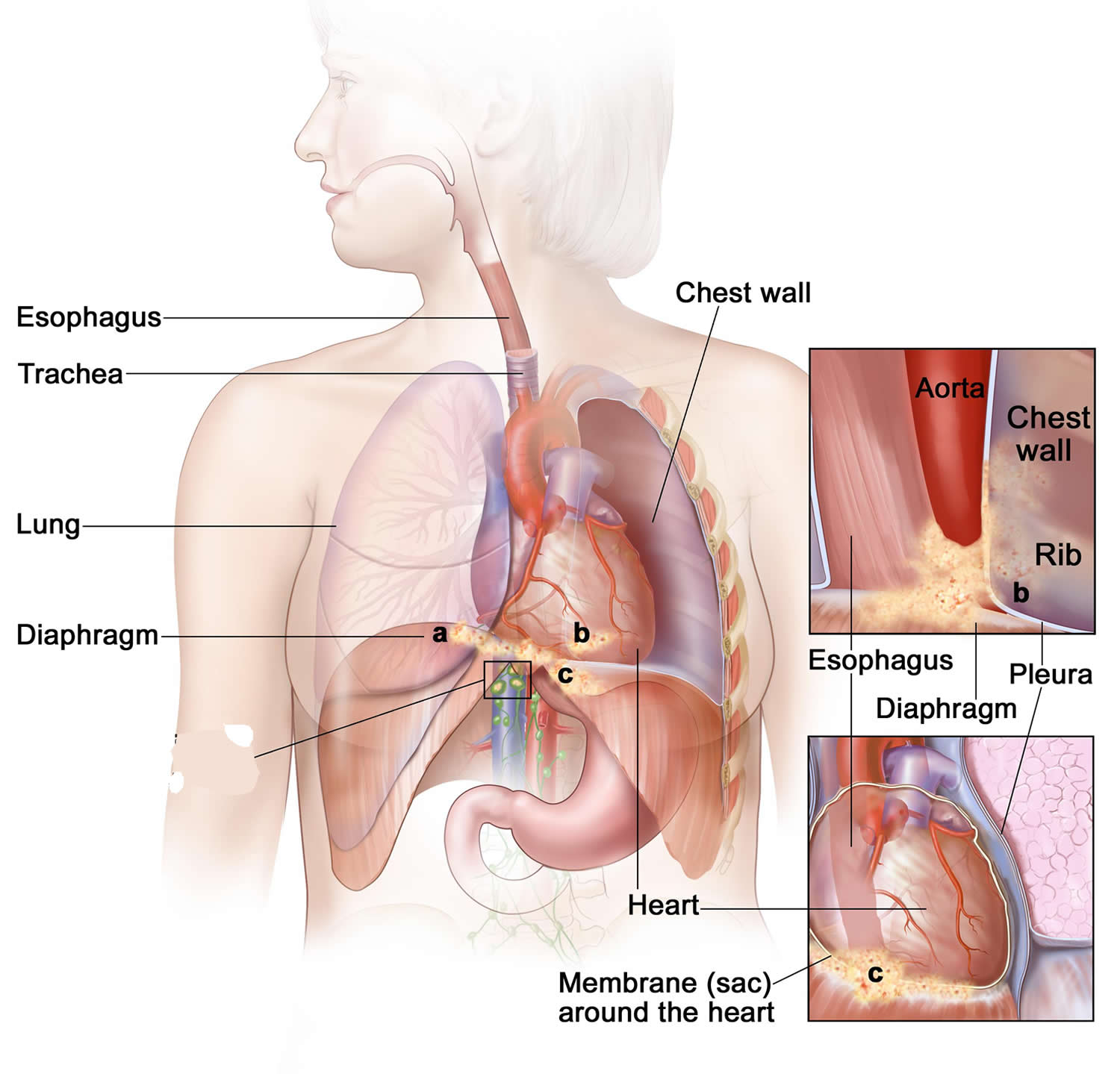Contents
What is esophagus spasm ?
Esophageal spasms are painful and abnormal contractions within the muscular tube connecting your mouth and stomach (esophagus) 1. Esophageal spasms can feel like sudden, severe chest pain that lasts from a few minutes to hours 2.
Esophageal spasms typically occur only occasionally and might not need treatment. But sometimes the spasms are frequent and can prevent food and liquids from traveling through the esophagus. If esophageal spasms interfere with your ability to eat or drink, treatments are available.
Figure 1. Esophagus

Signs and symptoms of esophageal spasms
Signs and symptoms of esophageal spasms include:
- Squeezing pain in your chest. The pain is often intense, and you might mistake it for heart pain (angina or heart attack).
- Difficulty swallowing, sometimes related to swallowing specific substances, such as red wine or extremely hot or cold liquids.
- The feeling that an object is stuck in your throat.
- The return of food and liquids back up your esophagus (regurgitation).
It can be hard to tell an esophagus spasm from a heart attack. The pain may spread to the neck, jaw, arms, or back.
- The squeezing chest pain associated with esophageal spasms can also be caused by a heart attack. If you experience squeezing chest pain, seek immediate medical care.
The symptoms of a heart attack can vary from person to person.
- If you think you or someone else is having a heart attack, even if you’re not sure, don’t feel embarrassed to call your local emergency number right away !
- Quick Action Can Save Your Life !
- Don’t Wait–Get Help Quickly
- Do not drive to the hospital or let someone else drive you. Call an ambulance so that medical personnel can begin life-saving treatment on the way to the emergency room. Take a nitroglycerin pill if your doctor has prescribed this type of treatment.
What You Must Do If You Have Chest Pain ?
ALL patients suffering from chest pain must have thorough cardiac evaluations to ensure they do not have heart disease prior to being labeled as having esophageal spasms chest pain.
Why is heart pain and esophagus pain similar ?
The heart and the esophagus are located in the chest cavity (thorax) in close proximity (Figure 1). They receive very similar nerve supply. Thus, pain arising from either organ travel through the same nerve sensory fibers to the brain. As a result, the pain from either organ can have very similar features making it difficult to differentiate cardiac pain from esophageal (swallowing pipe) pain. It also indicates that a very common source of chest pain (non-cardiac) arises from the esophagus.
Figure 2. The heart and the esophagus are located in the chest in close proximity and also share same sensory nerves.
Causes of esophagus spasm
It’s not clear what causes esophageal spasms. However, they appear to be related to abnormal functioning of nerves that control the muscles you use when you swallow.
A healthy esophagus normally moves food into your stomach through a series of coordinated muscle contractions. Esophageal spasms make it difficult for the muscles in the walls of your lower esophagus to coordinate in order to move food to your stomach.
Very hot or very cold foods may trigger spasms in some people.
There are two types of esophageal spasms:
- Occasional contractions (diffuse esophageal spasms). This type of spasm may be painful and is often accompanied by regurgitation of food or liquids.
- Painfully strong contractions (nutcracker esophagus). Although painful, this type of spasm — also referred to as jackhammer esophagus — may not cause regurgitation of food or liquids.
Risk factors for spasm of the esophagus
Esophageal spasms are a rare condition. They tend to occur in people between the ages of 60 and 80, and may be associated with gastroesophageal reflux disease (GERD).
Other factors that can increase the risk of esophageal spasms include:
- High blood pressure
- Anxiety or depression
- Drinking red wine or consuming very hot or very cold foods or drinks
How is esophagus muscle spasm diagnosed ?
Your doctor might recommend:
- Esophagogastroduodenoscopy. A flexible tube (endoscope) that is passed down your throat allows your doctor to see the inside of the esophagus, stomach and upper small intestine. Your doctor may remove a tissue sample (biopsy) for testing to rule out other esophageal diseases.
- Esophagogram (barium swallow x-ray). Images of your esophagus are taken after you swallow a contrast liquid.
- Esophageal manometry. This test measures muscle contractions in your esophagus when you swallow water
- Esophageal pH monitoring. This test can determine if stomach acid is flowing back into your esophagus (acid reflux).
Esophagus spasm treatment
Treatment depends on the frequency and severity of your esophageal spasms.
If your spasms are occasional, your doctor might recommend avoiding trigger foods or situations.
If your spasms make it difficult to eat or drink, your doctor might recommend:
- Managing any underlying conditions. Esophageal spasms are sometimes associated with conditions such as heartburn, GERD, anxiety or depression. Your doctor might recommend a proton pump inhibitor — such as lansoprazole — to treat GERD, or an antidepressant, such as trazodone or imipramine (Tofranil). Antidepressants might also help reduce the sensation of pain in the esophagus.
- Medications to relax your swallowing muscles. Sildenafil (Revatio, Viagra), onobotulinumtoxin A (Botox) injections or calcium channel blockers, such as diltiazem (Cardizem CD, Tiazac, others), can reduce the severity of spasms.
- Surgery (myotomy). If medication doesn’t work, your doctor might recommend a procedure that involves cutting the muscle at the lower end of the esophagus, to weaken esophageal contractions. Long-term studies of this approach aren’t available, so myotomy generally isn’t recommended for esophageal spasms. However, it might be considered if other treatments don’t work.
- Peroral endoscopic myotomy (POEM). In this new minimally invasive technique, an endoscope inserted through your mouth and down your throat allows an incision in the inside lining of your esophagus. Then, as in myotomy, the surgeon cuts the muscle at the lower end of the esophagus. Like myotomy, POEM is usually considered only if other treatments don’t work.
Lifestyle and home remedies
To help you cope with occasional esophageal spasms, try to:
- Avoid your triggers. Make a list of foods and beverages that cause your esophageal spasms.
- Choose food that is warm or cool. Let foods and drinks that are very hot or very cold sit for a bit before eating or drinking them.
- Find ways to control stress. Esophageal spasms may be more common or more severe when you’re stressed.
- Suck a peppermint lozenge. Peppermint oil is a smooth-muscle relaxant and might help ease esophageal spasms. Place the peppermint lozenge under your tongue.






